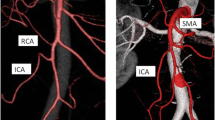Abstract
Purpose
In women, the uterine artery is the main branch of the internal iliac artery, vascularizing most of the uterus. Knowledge of its origin and variations is essential during extensive gynaecological surgery and interventional radiological procedures. We aimed to investigate its origin and explore its anatomical variations by three-dimensional (3D) reconstructed computed tomography (CT) angiography.
Methods
This was a retrospective, monocentric observational study involving CT scans of the abdomen and lower limbs of women < 50 years old with 3D reconstructed CT images of the internal and external iliac arterial axes.
Results
Between 01 January 2014 and 31 December 2015, among 986 cases of CT scans performed in women, for all indications, 3D reconstructed images for 43 women could be analysed. The uterine artery originated from a common trunk with the umbilical artery in 62.7% of cases, from a direct branch of the internal iliac artery in 25.6% of cases, directly from the superior gluteal artery in 9.3% of cases and from the internal pudendal artery in 2.3%.
Conclusions
Three-dimensional(3D) reconstructed CT angiography can detect the point of origin of the uterine artery. Therefore, it can be used as a mapping tool of the pelvic arterial tree. Our study corroborates data from the literature that the uterine artery most often originates from a common trunk with the umbilical artery. However, surgeons and intervention radiologists must be aware of the variability of its origin to facilitate the safety of the patients during procedures.



Similar content being viewed by others
References
Adachi B (1928) Das arterien aystem der japaner, Band II. Verlag der Keiserlich-Japanischen Universitat zu Kyoto (9):95–125
Akinwande O, Ahmad A, Ahmad S, Coldwell D (2015) Review of pelvic collateral pathways in aorto-iliac occlusive disease: demonstration by CT angiography. Acta Radiol 56:419–427. https://doi.org/10.1177/0284185114528172
Ashley FL, Anson BJ (1941) The hypogastric artery in American Whites and Negroes. Am J Phys Anthropol 28(4):381–395. https://doi.org/10.1002/ajpa.1330280404
Braf ZF, Koontz WW (1977) Gangrene of bladder. Complication of hypogastric artery embolization. Urology 9:670–671
Cabrol C (1981) Anatomie. Flammarion, Paris
Chantalat E, Merigot O, Chaynes P et al (2014) Radiological anatomical study of the origin of the uterine artery. Surg Radiol Anat SRA 36:1093–1099. https://doi.org/10.1007/s00276-013-1207-0
Gomez-Jorge J, Keyoung A, Levy EB, Spies JB (2003) Uterine artery anatomy relevant to uterine leiomyomata embolization. Cardiovasc Intervent Radiol 26:522–527
Gray H (1995) Anatomy descriptive and surgical. Sunburst Books, London
Greenwood LH, Glickman MG, Schwartz PE et al (1987) Obstetric and non-malignant gynecologic bleeding: treatment with angiographic embolization. Radiology 164:155–159. https://doi.org/10.1148/radiology.164.1.3495816
Holub Z, Lukac J, Kliment L, Urbanek S (2005) Variability of the origin of the uterine artery: laparoscopic surgical observation. J Obstet Gynaecol Res 31:158–163. https://doi.org/10.1111/j.1341-8076.2005.00264.x
Lipshutz B (1918) A composite study of the hypogastric artery and its branches. Ann Surg 67(5):584–608
Merland JJ, Chiras J (1981) Arteriography of the pelvis: diagnostic and therapeutic procedures. Springer, Berlin
Naguib NNN, Nour-Eldin N-EA, Hammerstingl RM et al (2008) Three-dimensional reconstructed contrast-enhanced MR angiography for internal iliac artery branch visualization before uterine artery embolization. J Vasc Interv Radiol JVIR 19:1569–1575. https://doi.org/10.1016/j.jvir.2008.08.012
Naguib NN, Nour-Eldin NE, Lehnert T, Hammerstingl RM, Korkusuz H, Eichler K, Zangos S, Vogl TJ (2009) Uterine artery embolization: optimization with preprocedural prediction of the best tube angle obliquity by using 3D-reconstructed contrast-enhanced MR angiography. Radiology 251(3):788–795. https://doi.org/10.1148/radiol.2513081751
Nikolic B, Spies JB, Abbara S, Goodwin SC (1999) Ovarian artery supply of uterine fibroids as a cause of treatment failure after uterine artery embolization: a case report. J Vasc Interv Radiol JVIR 10:1167–1170
Obimbo MM, Ogeng’o JA, Saidi H (2010) Variant anatomy of the uterine artery in a Kenyan population. Int J Gynaecol Obstet 111(1):49–52. https://doi.org/10.1016/j.ijgo.2010.04.033
Oz M, Hazirolan T, Turkbey B et al (2010) CT angiography evaluation of the renal vascular pathologies: a pictorial review. JBR-BTR Organe Soc R Belge Radiol SRBR Orgaan Van K Belg Ver. Voor Radiol KBVR 93:252–257
Payne JF, Haney AF (2003) Serious complications of uterine artery embolization for conservative treatment of fibroids. Fertil Steril 79:128–131
Pelage JP, Le Dref O, Soyer P et al (1999) Arterial anatomy of the female genital tract: variations and relevance to transcatheter embolization of the uterus. AJR Am J Roentgenol 172:989–994. https://doi.org/10.2214/ajr.172.4.10587133
Pelage JP, Walker WJ, Le Dref O, Rymer R (2003) Ovarian artery: angiographic appearance, embolization and relevance to uterine fibroid embolization. Cardiovasc Intervent Radiol 26:227–233
Peters A, Stuparich MA, Mansuria SM, Lee TTM (2016) Anatomic vascular considerations in uterine artery ligation at its origin during laparoscopic hysterectomies. Am J Obstet Gynecol 215:393.e1–3. https://doi.org/10.1016/j.ajog.2016.06.004
Ravina JH, Herbreteau D, Ciraru-Vigneron N et al (1995) Arterial embolisation to treat uterine myomata. Lancet Lond Engl 346:671–672
Roberts WH, Krishingner GL (1967) Comparative study of human internal iliac artery based on Adachi classification. Anat Rec 158:191–196. https://doi.org/10.1002/ar.1091580208
Roman H, Zanati J, Friederich L et al (2008) Laparoscopic hysterectomy of large uteri with uterine artery coagulation at its origin. JSLS J Soc Laparoendosc Surg Soc Laparoendosc Surg 12:25–29
Vashisht A, Studd JW, Carey AH et al (2000) Fibroid embolisation: a technique not without significant complications. BJOG Int J Obstet Gynaecol 107:1166–1170
Author information
Authors and Affiliations
Corresponding author
Ethics declarations
Ethical approval
All procedures performed in studies involving human participants were in accordance with the ethical standards of the institutional and/or national research committee and with the 1964 Helsinki declaration and its later amendments or comparable ethical standards.
Informed consent
For this retrospective study, formal consent is not required.
Conflict of interest
The authors declare that they have no conflict of interest.
Rights and permissions
About this article
Cite this article
Arfi, A., Arfi-Rouche, J., Barrau, V. et al. Three-dimensional computed tomography angiography reconstruction of the origin of the uterine artery and its clinical significance. Surg Radiol Anat 40, 85–90 (2018). https://doi.org/10.1007/s00276-017-1941-9
Received:
Accepted:
Published:
Issue Date:
DOI: https://doi.org/10.1007/s00276-017-1941-9




